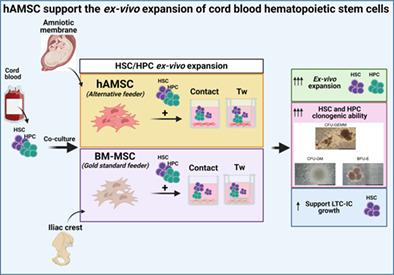当前位置:
X-MOL 学术
›
Stem Cells Transl. Med.
›
论文详情
Our official English website, www.x-mol.net, welcomes your
feedback! (Note: you will need to create a separate account there.)
Human amniotic mesenchymal stromal cells support the ex vivo expansion of cord blood hematopoietic stem cells
STEM CELLS Translational Medicine ( IF 5.4 ) Pub Date : 2021-07-29 , DOI: 10.1002/sctm.21-0130 Valentina Orticelli 1, 2 , Andrea Papait 1, 3 , Elsa Vertua 3 , Patrizia Bonassi Signoroni 3 , Pietro Romele 3 , Lorena Di Pietro 1 , Marta Magatti 3 , Luciana Teofili 2 , Antonietta Rosa Silini 3 , Ornella Parolini 1, 2
STEM CELLS Translational Medicine ( IF 5.4 ) Pub Date : 2021-07-29 , DOI: 10.1002/sctm.21-0130 Valentina Orticelli 1, 2 , Andrea Papait 1, 3 , Elsa Vertua 3 , Patrizia Bonassi Signoroni 3 , Pietro Romele 3 , Lorena Di Pietro 1 , Marta Magatti 3 , Luciana Teofili 2 , Antonietta Rosa Silini 3 , Ornella Parolini 1, 2
Affiliation

|
Currently, more than 30 000 allogeneic hematopoietic stem cell (HSC) transplantations have been performed for the treatment of hematological and nonhematological diseases using HSC from umbilical cord blood (CB). However, the wide utilization of CB as a source of HSC is limited by the low number of cells recovered. One strategy to expand ex vivo CB-HSC is represented by the use of bone marrow mesenchymal stromal cells (BM-MSCs) as a feeder to enhance HSC proliferation while maintaining HSC stemness. Indeed, BM-MSCs have been recognized as one of the most relevant players in the HSC niche. Thus, it has been hypothesized that they can support the ex vivo expansion of HSC by mimicking the physiological microenvironment present in the hematopoietic niche. Due to the role of placenta in supporting fetal hematopoiesis, MSC derived from the amniotic membrane (hAMSC) of human term placenta could represent an interesting alternative to BM-MSC as a feeder layer to enhance the proliferation and maintain HSC stemness. Therefore, in this study we investigated if hAMSC could support the ex vivo expansion of HSC and progenitor cells. The capacity of hAMSCs to support the ex vivo expansion of CB-HSC was evaluated in comparison to the control condition represented by the CB-CD34+ cells without a feeder layer. The coculture was performed at two different CD34+:MSC ratios (1:2 and 1:8) in both cell-to-cell contact and transwell setting. After 7 days, the cells were collected and analyzed for phenotype and functionality. Our results suggest that hAMSCs represent a valuable alternative to BM-MSC to support: (a) the ex vivo expansion of CB-HSC in both contact and transwell systems, (b) the colony forming unit ability, and (c) long-term culture initiating cells ability. Overall, these findings may contribute to address the unmet need of high HSC content in CB units available for transplantation.
中文翻译:

人羊膜间充质基质细胞支持脐带血造血干细胞的离体扩增
目前,已经进行了超过 30 000 例异基因造血干细胞 (HSC) 移植,用于使用来自脐带血 (CB) 的 HSC 治疗血液和非血液疾病。然而,CB 作为 HSC 来源的广泛利用受到回收细胞数量少的限制。体外扩增 CB-HSC 的一种策略是使用骨髓间充质基质细胞 (BM-MSCs) 作为饲养层来增强 HSC 增殖,同时保持 HSC 干性。事实上,BM-MSCs 已被公认为 HSC 利基市场中最相关的参与者之一。因此,假设它们可以通过模拟造血生态位中存在的生理微环境来支持 HSC 的离体扩增。由于胎盘在支持胎儿造血中的作用,源自人类足月胎盘羊膜 (hAMSC) 的 MSC 可以代表 BM-MSC 作为饲养层的有趣替代品,以增强增殖和维持 HSC 干性。因此,在这项研究中,我们研究了 hAMSC 是否可以支持 HSC 和祖细胞的离体扩增。与 CB-CD34 代表的对照条件相比,评估了 hAMSCs 支持 CB-HSC 离体扩增的能力+没有饲养层的细胞。在细胞与细胞接触和 transwell 设置中,以两种不同的 CD34 + :MSC 比率(1:2 和 1:8)进行共培养。7天后,收集细胞并分析表型和功能。我们的研究结果表明,hAMSCs 是 BM-MSC 的一种有价值的替代品,可支持:(a) CB-HSC 在接触和 transwell 系统中的离体扩增,(b) 集落形成单位能力,和 (c) 长期培养起始细胞的能力。总体而言,这些发现可能有助于解决可用于移植的 CB 单位中高 HSC 含量的未满足需求。
更新日期:2021-07-29
中文翻译:

人羊膜间充质基质细胞支持脐带血造血干细胞的离体扩增
目前,已经进行了超过 30 000 例异基因造血干细胞 (HSC) 移植,用于使用来自脐带血 (CB) 的 HSC 治疗血液和非血液疾病。然而,CB 作为 HSC 来源的广泛利用受到回收细胞数量少的限制。体外扩增 CB-HSC 的一种策略是使用骨髓间充质基质细胞 (BM-MSCs) 作为饲养层来增强 HSC 增殖,同时保持 HSC 干性。事实上,BM-MSCs 已被公认为 HSC 利基市场中最相关的参与者之一。因此,假设它们可以通过模拟造血生态位中存在的生理微环境来支持 HSC 的离体扩增。由于胎盘在支持胎儿造血中的作用,源自人类足月胎盘羊膜 (hAMSC) 的 MSC 可以代表 BM-MSC 作为饲养层的有趣替代品,以增强增殖和维持 HSC 干性。因此,在这项研究中,我们研究了 hAMSC 是否可以支持 HSC 和祖细胞的离体扩增。与 CB-CD34 代表的对照条件相比,评估了 hAMSCs 支持 CB-HSC 离体扩增的能力+没有饲养层的细胞。在细胞与细胞接触和 transwell 设置中,以两种不同的 CD34 + :MSC 比率(1:2 和 1:8)进行共培养。7天后,收集细胞并分析表型和功能。我们的研究结果表明,hAMSCs 是 BM-MSC 的一种有价值的替代品,可支持:(a) CB-HSC 在接触和 transwell 系统中的离体扩增,(b) 集落形成单位能力,和 (c) 长期培养起始细胞的能力。总体而言,这些发现可能有助于解决可用于移植的 CB 单位中高 HSC 含量的未满足需求。










































 京公网安备 11010802027423号
京公网安备 11010802027423号